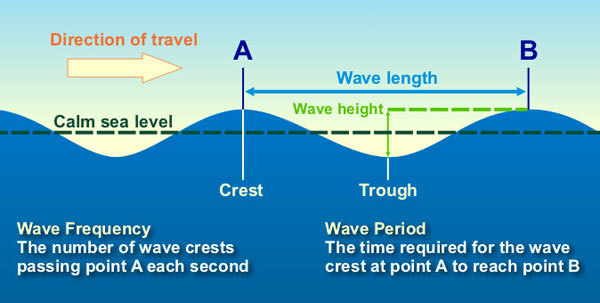9th Grade > Physics
SOUND MCQs
Total Questions : 57
| Page 1 of 6 pages
Answer: Option C. -> 4 km
:
C
Given:
Speed of ultrasound in seawater,v=1600ms−1
Time for sound to travel from ship to seabed and then back, t=5s
Letthe distance between ship and seabed be d.
The totaldistance travelled by the sound waves will be 2d.
Distance travelled by the wave is the product ofspeed and time.
2d=vt=1600×5=8000m
d=80002=4000m=4km
Hence, the distance of seabed from ship is 4km
:
C
Given:
Speed of ultrasound in seawater,v=1600ms−1
Time for sound to travel from ship to seabed and then back, t=5s
Letthe distance between ship and seabed be d.
The totaldistance travelled by the sound waves will be 2d.
Distance travelled by the wave is the product ofspeed and time.
2d=vt=1600×5=8000m
d=80002=4000m=4km
Hence, the distance of seabed from ship is 4km
Answer: Option B. -> False
:
B

Longitudinal waves are the type of waves in which the particles vibrate along the direction of propagation of wave. Transverse waves are those inwhich the particles vibrate perpendicular to the direction of propagation of wave. In case of ocean waves, the particles vibrate perpendicular to the direction of propagation of wave, soit is a transverse wave.
:
B

Longitudinal waves are the type of waves in which the particles vibrate along the direction of propagation of wave. Transverse waves are those inwhich the particles vibrate perpendicular to the direction of propagation of wave. In case of ocean waves, the particles vibrate perpendicular to the direction of propagation of wave, soit is a transverse wave.
Answer: Option A. -> amplitude
:
A
Loudness determines the magnitude of the auditory sensation produced.More the intensity of sound wave, more is the loudness. Intensity of the sound wave depends on the energy per unit volume in the wave. Energy itself is proportional to the (square of) amplitude of the wave.
:
A
Loudness determines the magnitude of the auditory sensation produced.More the intensity of sound wave, more is the loudness. Intensity of the sound wave depends on the energy per unit volume in the wave. Energy itself is proportional to the (square of) amplitude of the wave.
Answer: Option A. -> 4.86 s
:
A
Given, speed of sound, v=350ms−1 and distance between the observer and the cliff, d=850m.
This is a case of an echo, so distance travelled = 2d (because sound travels from the observer to the cliff and back to the observer)
We know, speed=distancetime
v=2dt
⇒t=2dv
=(2×850)350=4.86s.
:
A
Given, speed of sound, v=350ms−1 and distance between the observer and the cliff, d=850m.
This is a case of an echo, so distance travelled = 2d (because sound travels from the observer to the cliff and back to the observer)
We know, speed=distancetime
v=2dt
⇒t=2dv
=(2×850)350=4.86s.
Answer: Option D. -> Sound cannot propagate in outer space.
:
D
Sound needs a medium to travel, but outer space has no atmosphere. Thereforesound cannot travel in outer space. This is the reason why people cannot talk to each other in vacuum.
:
D
Sound needs a medium to travel, but outer space has no atmosphere. Thereforesound cannot travel in outer space. This is the reason why people cannot talk to each other in vacuum.
Answer: Option C. -> rarefactions
:
C
Sound waves are a sequence of compressions and rarefactions. A compression is a region in a longitudinal wave where the particles are closer than normal. A rarefaction is a region in a longitudinal wave where the particles are farther than normal.
:
C
Sound waves are a sequence of compressions and rarefactions. A compression is a region in a longitudinal wave where the particles are closer than normal. A rarefaction is a region in a longitudinal wave where the particles are farther than normal.
Answer: Option D. -> Electrocardiography
:
D
In electrocardiography (also known as ECG or EKG), ultrasonic waves are made to reflect from various parts of the heart and an image of the heart is produced. For this, electrodes are placed on the skin of the limbs and chest. It helps to understand the irregularities in heart rythm.
:
D
In electrocardiography (also known as ECG or EKG), ultrasonic waves are made to reflect from various parts of the heart and an image of the heart is produced. For this, electrodes are placed on the skin of the limbs and chest. It helps to understand the irregularities in heart rythm.
Answer: Option B. -> Wavelength is inversely proportional to frequency
:
B
λ=vf
where:
λ: Wavelength
f: Frequency
v: Speed of light in the given medium
In a medium, speed is constant.
⟹λ∝1f
Hence, wavelength is inversely proportional to frequency in a medium.
:
B
λ=vf
where:
λ: Wavelength
f: Frequency
v: Speed of light in the given medium
In a medium, speed is constant.
⟹λ∝1f
Hence, wavelength is inversely proportional to frequency in a medium.
Answer: Option B. -> 80000 Hz
:
B
Given:
Speed of sound wave, v=1600ms−1
Wavelength, λ=2cm=0.02m
Let f be the frequency of the wave.
Speed of sound is given by:
v=fλ
f=1600ms−10.02m=80000Hz.
Frequency of the sound wave is 80000Hz.
:
B
Given:
Speed of sound wave, v=1600ms−1
Wavelength, λ=2cm=0.02m
Let f be the frequency of the wave.
Speed of sound is given by:
v=fλ
f=1600ms−10.02m=80000Hz.
Frequency of the sound wave is 80000Hz.
Answer: Option B. -> vibration of the membrane
:
B
When a drum is beaten, the membrane of the drum vibrates which can be felt by touching it and the sound is heard. As the membrane stops vibrating, no sound is heard. The vibrating drum produces sound.
:
B
When a drum is beaten, the membrane of the drum vibrates which can be felt by touching it and the sound is heard. As the membrane stops vibrating, no sound is heard. The vibrating drum produces sound.
















